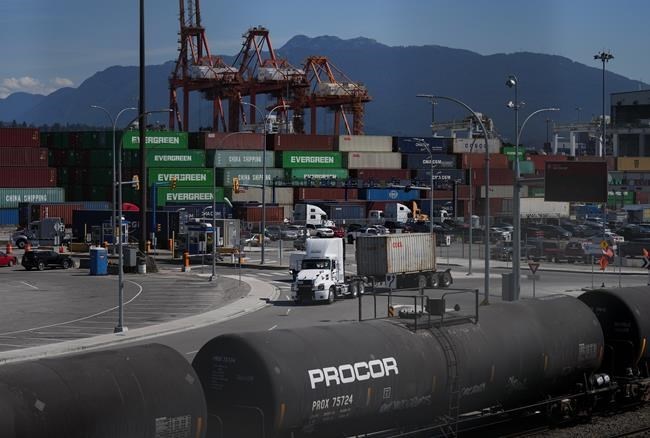MONTREAL — Airlines and marine shippers have asked Ottawa to beef up funding for sustainable transport, money they hope will flow toward green supply chains and upgrades to existing infrastructure.
Tax credits, loans and grants are essential to help companies reduce greenhouse-gas emissions and keep pace with other nations' transportation networks, according to a pair of transportation groups ahead of the federal budget set to be tabled April 16.
Investors and would-be suppliers need incentives to start churning out sustainable aviation fuel (SAF) — not a drop of which is produced domestically — to match new programs in the United States that aim to cut airplane pollution, the National Airlines Council of Canada says.
"Airlines have sent very clear demand signals they will buy every drop of SAF produced, and yet what's missing from the equation is any sort of federal incentive or support, unlike most other western countries, including the U.S.," CEO Jeff Morrison said in an interview.
Typically derived from used cooking oils, animal fats or organic waste, green jet fuel shaves off about 80 per cent of a plane's emissions.
The federal government has set a goal of 10 per cent green jet fuel use by 2030. Last year, it pledged $350 million to support decarbonization of the aerospace sector, establishing a national network that backs research and development projects ranging from alternative fuels to aircraft design. But the blueprint offered none of the manufacturing carrots that carriers were demanding, Morrison said.
Airlines have two main requests they believe will foster fuel-making factories and long-term output by producers: an investment tax credit at a rate of 50 per cent on manufacturing facilities and a production tax credit with a 10-year horizon — on par with an incentive south of the border.
U.S. producers are already eligible for a tax credit of up to US$1.75 per gallon (3.8 litres) under the Inflation Reduction Act.
Meanwhile, the Chamber of Marine Commerce says both a green shipping corridor program launched last year and a seven-year-old National Trade Corridor Fund needa big top-up. Electrification of ports, whose equipment runs mainly on fossil fuels, is one example of how cash could be funnelled toward emissions reduction.
If such efforts aren't undertaken, U.S. ports could start to draw shippers away from Canadian terminals, warned chamber CEO Bruce Burrows, who pointed to cargo vessels' self-unloading conveyor systems, which are "very power-hungry."
"They run off fuel on the ship, those systems, which have generators and then power up the conveyor belts," he noted in an interview.
"To electrify all of that by plugging into an electrical grid on shore, it's just like taking your vacuum cleaner up to the dock and then you plug it into someone's plug on the shore and you use their electricity," he said. "You're going to have to pay for it, but it'll be much more efficient, cost-effective and no GHGs."
The government's $165.4-million green shipping corridor program, which kicked off in December, looks to develop clean fuels and technologies at major ports as well as vessels that run on green hydrogen or advanced biofuels.
The federal government also administers a $4.6-billion program to bolster a variety of transportation infrastructure. Given a good grade overall by auditor general Karen Hogan last month, the National Trade Corridors Fund was launched in 2017 in an effort to strengthen the country's network of roads, rails, airports and seaports by 2028. The projects by municipal and provincial governments as well as private companies range from routine street upgrades to multibillion-dollar port terminals.Â
But airlines and shippers want even more money for infrastructure improvement projects, partly to keep up with the funding tsunami unleashed south of the border by the Biden administration's US$1.2-trillion infrastructure bill in 2021.
The airlines council, which represents four of the country's biggest carriers including Air Canada and WestJet, hopes the government will allow airports to "reinvest" the rent they pay Ottawa into airport upgrades, on top of making them eligible to apply for infrastructure programs.
In the 2022-23 fiscal year, airports handed over $419 million in ground rent to federal coffers, a 42-per-cent increase from nine years earlier, according to a study from the Montreal Economic Institute.
"As a result, airport infrastructure lacks competitiveness, especially compared to the U.S." — where airports rely much more directly on federal funding — said Morrison.
"The federal government sees air travel as a cash cow."
A higher security fee — it jumps by a third to as much as $34 per traveller starting May 1 — as well as passenger compensation reforms now being drafted do little to sharpen competitive edge in Canada, he added.
As for nautical competition, the Chamber of Marine Commerce has called on the government to rethink a new national certification program for ship pilots that it claims will be "costly," "complex" and laden with "red tape."
"That will ultimately be a disincentive for our pilots to become certified," Burrows said. Shippers fear they will have to start subsidizing the cost of obtaining a licence to attract future boat captains, he said.
Currently, four regional pilotage authorities oversee the certification process.
The chamber also hopes to see more funding for the National Trade Corridor Fund as well as the Canada Border Services Agency to ramp up customs clearance capacity on the Great Lakes, as "insufficient staff ... is having the net effect of restricting trade and increasing costs."
This report by The Canadian Press was first published April 1, 2024.
Companies in this story: (TSX:AC)
Christopher Reynolds, The Canadian Press




